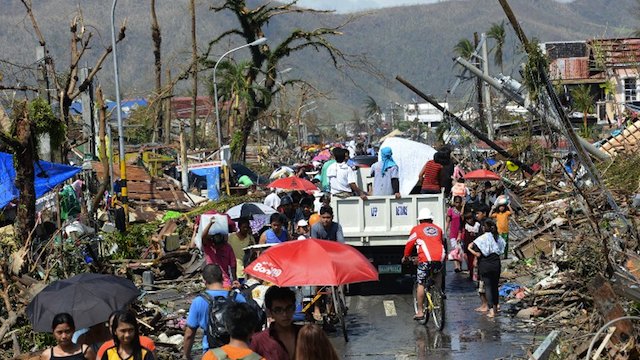SUMMARY
This is AI generated summarization, which may have errors. For context, always refer to the full article.

MANILA, Philippines – Three days since Super Typhoon Yolanda ravaged central Philippines, Secretary to the Cabinet Rene Almendras admitted to reporters in Malacañang that some areas hit by Yolanda have yet to be reached by the government.
“I wish I can tell you we’ve reached all areas, but even last night, I had difficulty sleeping because I was thinking, maybe there are areas that have not yet been reached,” Almendras said.
Almendras was with President Benigno Aquino III on Sunday when the Chief Executive visited Eastern Visayas – specifically Tacloban City, Leyte – which so far has sustained the most damage.
“Today I made a request to the forward command center to send a chopper to scan an area because there are supposedly people there who have not been reached. So we are not ready to say all areas have been reached,” Almendras said.
He said they were most concerned about “remote locations,” which only had 10-20 houses, and far-flung areas like mountains, but said he did not think the areas yet to be surveyed are that extensive.
“My experience with [Typhoon] Pablo, since I was there as well, is that [the isolated areas] are not that many. But no matter how few, we still need to reach them, don’t we? So we’re focusing on that. We want to reach them and ‘them’ means everyone. That’s the instruction of the President,” he said.
Almendras, however, failed to give the names of specific areas that have yet to be penetrated but Public Works and Highways Secretary Rogelio Singson told Rappler, “Eastern Samar, particularly Borongan and Guiuan,” are still unreachable by land, because of “ongoing clearing of national roads.”
The towns of Guiuan and Giporlos in Eastern Samar are in ruins.
In the province of Samar, a local disaster chief said 300 people were killed in the small town of Basey while another 2,000 were missing there and elsewhere on Samar.
On Friday, November 8, one of the world’s strongest typhoons made landfall in the Philippines. Packing maximum sustained winds of 315 km (195 miles) an hour, it broke down houses and took hundreds of lives. Dead bodies lined the streets made impassable by fallen trees and rubble, as the national government scrambled to provide aid to desperate survivors and local governments rendered helpless by the massive damage brought by the storm.
Officials continue to count the number of deaths, but the lack of communications and blocked roads make the surveying difficult.
‘Floating corpses’
Almendras said the Air Force continued to scan communities from above, looking for areas where they are needed to drop off supplies. (READ: Fast Facts: Eastern Visayas)
According to Almendras, the pilots said they had not seen many survivors.
“Yesterday, I was talking to our pilots and asked them, ‘Have you seen a lot of survivors?’ [They said}, ‘Sec, not many.’ They flew over islands. Unfortunately, what they’ve seen are floating corpses,” he said.
This is why providing fuel to helicopters remains a priority, Almendras said, so they can continue with operations in scanning isolated areas.
But the government said efforts are slowly being felt in areas that are reachable by the government. (READ: After Yolanda, int’l community offers sympathy, aid)
In Tacloban, major communications networks Smart and Globe have restored signal, said Almendras, after its cell sites were toppled by the storm making the city difficult to reach. The Commission on Elections (Comelec) has also agreed to lend generators that were not used in the past elections to affected areas, in order to restore power.
“[Sec Singson] is sending a group of people to the COMELEC warehouse, where they will choose working generators and we hope to dispatch that today,” he said.
Additionally, the government has airlifted victims who wanted to leave Tacloban and go to their relatives, while the Department of Transportation and Communications (DOTC) is organizing buses to transport survivors from Tacloban to Manila since commercial flights between the two cities are still not operational.
‘Not the time for blame’
As the extent of the typhoon’s damage slowly comes to light, Almendras said it was not the right time to assess who is at fault and whether there was a lack of preparation on the part of local government units.
He said the President is focused instead on the challenge that lies ahead. (READ: Tormented typhoon victims scour for food)
“When we got to Roxas City, in the meeting with the local DRRMC (Disaster Risk Reduction and Management Council), the President said: ‘Don’t tell what you did, or what happened, because we’re here now. We’re pressed for time. We need to respond, we need to move. I want you to tell me what we need to do, and we need to do it,” Almendras said.
While he admitted the national government is having difficulty coordinating with local governments and reiterated that it is crucial they organize themselves well in order to be efficient, he clarified the administration “is not blaming anyone” and this is “not the right time to judge.”
“That’s difficult to say because [local officials] too were affected,” Almendras said.
He said he spoke to locals in Tacloban who made him realize “this was something else” after they told him they were ready for the strong winds, but not for the unprecedented amount of water.
“They were not ready for [the water]. In some areas, it was 15 feet, it reached the ceiling of the second floor. So maybe when we’ve fixed the current problems, and we’ve helped all those we’ve needed to help, then we can talk about it in the context of learning from it,” he said. – Rappler.com
Add a comment
How does this make you feel?
There are no comments yet. Add your comment to start the conversation.